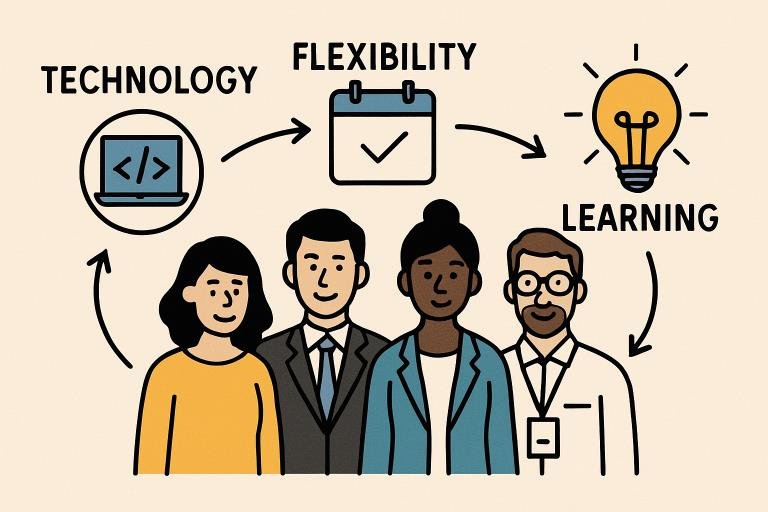Why Future-Proofing Talent Is Crucial
The acceleration of technological progress, shifting demographics, and rapidly evolving business models have made adaptability the top priority for organizations. Future-proofing talent involves developing skills, mindsets, and structures that enable employees to pivot and respond to ongoing changes. By investing now in the right development approaches, organizations can withstand uncertainty and outpace competitors. Leveraging a talent management tool allows organizations to identify future skill requirements, align development with strategic goals, and continuously monitor progress. Such tools drive smart decision-making and targeted growth—keeping teams resilient, prepared, and engaged.
As automation and digital transformation reshape industries, future-ready strategies address skill gaps before they become business obstacles. According to a recent World Economic Forum report, nearly half of all work activities could soon be automated, but technical skills alone are not enough. Human qualities such as critical thinking, problem-solving, and collaboration remain core to driving innovation and navigating complex changes.
Key Drivers Shaping Workforce Trends
Multiple factors are converging to transform the world of work. Digitalization is redefining roles, while demographic changes—including an aging workforce and increased diversity—create new challenges and opportunities. Economic volatility, from global supply chain disruptions to geopolitical events, demands a workforce capable of rapid adaptation. Organizations need talent strategies that are flexible, inclusive, and attuned to both macro and micro changes in the industry landscape. According to the Society for Human Resource Management (SHRM), adaptability and emotional intelligence are now vital, as organizations look for talent who can thrive in ambiguity and support collaborative, agile environments.
For companies to address emerging needs robustly, a proactive approach is vital—anticipating trends, staying informed on market shifts, and investing in continuous learning and development opportunities for their teams.
Building Agility Into Team Structures
Agility is more than a buzzword; it is a transformative approach to structuring organizations. Agile teams are cross-functional, quick to respond, and empowered to make decisions. Rather than operating in rigid silos, these teams leverage a blend of expertise, fostering innovation and enabling rapid reactions to new opportunities or threats. Many industry leaders have demonstrated the power of agile models—like tech companies forming “sprint” teams during crises to solve customer challenges in record time.
Agile structures encourage open communication, ownership, and experimentation. These principles help companies minimize bureaucracy and maximize speed—a significant advantage in environments where project scopes can change rapidly, or competition accelerates unexpectedly.
Tech’s Role in Modern Talent Management
The integration of advanced technology is redefining how companies manage talent. From applicant tracking systems to AI-powered hiring, machine learning, and predictive analytics, technology empowers leaders to make data-driven HR decisions and proactively address skill gaps. Learning platforms now offer tailored reskilling and upskilling paths, engaging employees and cutting time-to-competency. However, true success comes from balancing technology with empathy and strategic vision, ensuring that digital solutions empower—not replace—human contributions. To explore effective digital solutions, Forbes offers a recent review of how technology is transforming talent management, highlighting real-world examples of technology adoption.
Meeting Employee Expectations in a New Era
Today’s workforce expects more than competitive pay and benefits. Flexibility, well-being support, and growth opportunities now define the employee experience. Transparent leadership and active listening build trust and loyalty, while development programs empower individuals to take ownership of their careers. Organizations that prioritize these expectations boost retention and foster a culture of ownership and creativity. As covered in a recent Harvard Business Review article, open communication and employee-driven change initiatives are game changers for company culture and engagement.
Reskilling and Upskilling for Ongoing Value
The need for new capabilities—ranging from digital literacy to emotional intelligence—is accelerating. A culture of continuous reskilling and upskilling helps organizations close key skills gaps, boost employee satisfaction, and remain competitive. Digital learning pathways, mentorship programs, and job rotations expand skill sets, while also engaging talent. Companies that support learning as an everyday activity cultivate agile, creative teams capable of facing whatever the future holds. As noted by McKinsey & Company, digital transformation succeeds where lifelong learning is embraced.
Measuring Success in Talent Strategies
Metrics and feedback loops are critical to evaluating and refining talent strategies. Common quantitative metrics include retention rates, time to fill positions, and engagement survey scores. Equally important is gathering qualitative input through ongoing check-ins, open forums, and employee surveys. Merging data and feedback reveals where strategies are working and highlights opportunities for refinement—creating a virtuous cycle of ongoing improvement and employee listening.
Balancing Automation with Human Touch
Automation provides consistency and efficiency, but high-value work still relies on uniquely human strengths. The most effective organizations use automation to free up teams from routine tasks, allowing greater focus on creative problem-solving, customer experience, and innovation. This emphasis on balance is crucial in fields like healthcare, hospitality, and customer service, where empathy, communication, and intuition are irreplaceable.
Staying Ahead: Continuous Learning and Adaptation
Organizations that make learning and adaptation core values stay one step ahead. Encouraging experimentation, rewarding innovation, and investing in professional growth not only fosters agility but also positions organizations to seize new opportunities while navigating risk. Building a future-ready talent strategy is about thriving amid change—empowering teams to respond, innovate, and adapt, regardless of what tomorrow brings.



